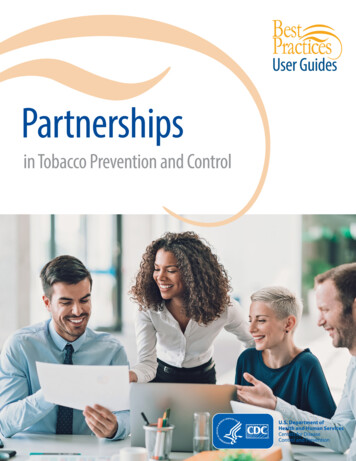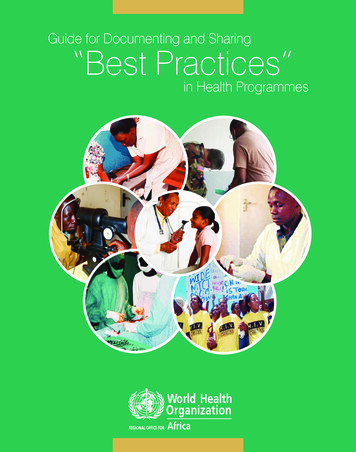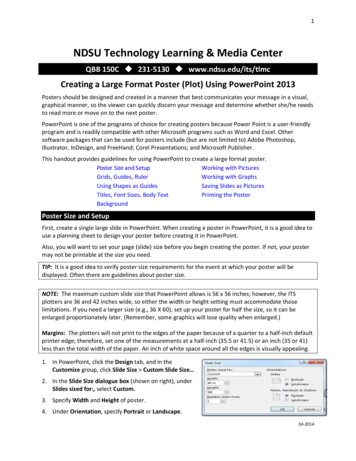
Transcription
Partnershipsin Tobacco Prevention and Control
AcknowledgementsThis guide was produced for the Centers for Disease Control and Prevention by the Center for PublicHealth Systems Science at the Brown School at Washington University in St. Louis.Primary contributors:Stephanie Andersen, Laura Brossart, Rebecca Ballard, Amy Endrizal, Erin Foster, Isaiah Zoschke, Tim Poor, ElyseVesser, Douglas Luke, Sarah Moreland-RussellInput was provided by:Cathy Callaway, Carissa Holmes, Joann Kang, Michon Mabry Jeter, Karla S. Sneegas, Renee WrightInput for the case studies was provided by:Tiffany Johnson, Mississippi Office of Tobacco ControlCharlotte Williams, Mississippi Office of Tobacco ControlCheryl Bettigole, Philadelphia Department of Public HealthRyan Coffman, Philadelphia Department of Public HealthOther contributions:Photographs on pages 5 and 24 courtesy of Gustavo Torrez, Campaign for Tobacco-Free KidsPhotographs on pages 14 and 15 courtesy of Cynthia Hallett, Americans for Nonsmokers’ RightsPhotographs on pages 16 and 28 courtesy of Carly Caminiti, Health Resources in ActionPhotograph on page 17 courtesy of Patty Barahona, Youth Leadership InstitutePhotograph on page 18 courtesy of Shaunda ScruggsPhotograph on page 19 courtesy of Sally Herndon, North Carolina Tobacco Prevention and Control BranchPhotograph on page 22 courtesy of John Daley, Colorado Public RadioPhotograph on page 37 courtesy of Wayne Tormala, Arizona Bureau of Tobacco and Chronic Disease
Table of ContentsGuide to the Reader 1Making the Case 2Brief History 3How to 4What are Partnerships in Commercial Tobacco Prevention and Control? 4Preparing to Partner 5Forming Coalitions 11Achieving Goals with Partners 14Advancing Health Equity and Reducing Disparities 25Working Together Effectively 29Evaluating Partnerships 32Sustaining Partnerships 36Providing Support 39Case Studies 40Case for Investment 44Resources 46References 53
GUIDE TO THE READERPurposeOrganizationThe Center for Public Health Systems Science atWashington University in St. Louis is developing aset of user guides funded by the Centers for DiseaseControl and Prevention (contract 75D30120C09195)for the Best Practices for Comprehensive TobaccoControl Programs—2014 (Best Practices 2014),an evidence-based tool to help states developcomprehensive tobacco control programs.18 Making the Case: A brief overview of why it isThe purpose of the user guides is to help tobaccocontrol staff and partners implement evidence-basedbest practices by translating research into practicalguidance. The guides focus on strategies (e.g., programsand interventions) that have shown strong or promisingevidence of effectiveness. Recommendations in thisguide are suggestions for programs working to developstrategic partnerships and coalitions. Programs canfollow these recommendations according to theirneeds, goals, and capacity.8 Providing Support: How tobacco controlContentThis user guide updates recommendations in the2009 Best Practices User Guide: Coalitions.2 State andcommunity partnerships continue to be essentialto change behavior and social norms aroundcommercial tobacco use.1 According to Best Practices2014, partnerships “can keep tobacco issues beforethe public, combat the tobacco industry, enhancecommunity involvement and promote communitybuy-in and support, educate decision makers, andhelp to inform policy change.”1 This guide expands therecommendations of the 2009 Coalitions user guide toinclude partnerships that form for a narrow, strategicpurpose and larger, more complex coalitions. It givesprogram managers information on how to developeffective partnerships and coalitions as a part of acomprehensive tobacco control program.Links to More InformationEach instance of italicized, bolded blue text in the guideindicates a link to an additional resource or a pagewithin the guide itself with more information. Websiteaddresses for all of the blue resources noted throughoutthe guide are also included in the Resources section.important for tobacco control programs to formpartnerships8 Brief History: How partnerships have led themovement to reduce commercial tobacco use8 How to: Strategies to involve partners incommercial tobacco prevention and control effortsprograms can support partnerships8 Case Studies: Real-world examples of howpartnerships have advanced commercial tobaccocontrol goals8 Case for Investment: Information to raiseawareness about the importance of commercialtobacco control partnerships8 Resources: Publications, toolkits, and websites tohelp in planning effortsBest Practices for ComprehensiveTobacco Control Programs–20141The Best Practices 2014 is an evidence-basedguide to help states plan, establish, andevaluate comprehensive commercial tobaccoprevention and control programs. The reportoffers recommendations and evidence for fiveessential components of effective programs: State and community interventions Cessation interventionsMass-reach health communicationinterventionsSurveillance and evaluationInfrastructure, administration, andmanagementPartnerships l 1
MAKING THE CASEMaking the Case for PartnershipsEnding the commercial tobacco use epidemic will require the coordinated efforts of many people.3 Partnerships cancreate the capacity to achieve goals that programs may not have the authority or flexibility to reach on their own. Asprograms are asked to do more with fewer resources, partnerships have become even more critical to commercialtobacco control efforts.4 Partnerships help programs:8 Develop synergyPartnerships bring together people with different strengths and experiences. When people pool their differentskills and knowledge to work toward a common goal, they are able to do more than they could on their own.58 Build capacityPartnerships help commercial tobacco control staff gain knowledge about different communities, learn newskills, and improve existing skills.6 In turn, partners develop relationships and skills that enhance their ability toaddress community problems.78 Drive policy changeThe most effective interventions combine program and policy strategies to influence social norms aboutcommercial tobacco use and exposure to secondhand smoke.1 Partners can lead policy change, informed by thescience and best practices.8 Enhance credibilityPartnerships get trusted leaders and reputable organizations involved in tobacco control issues.4 Their supportgenerates interest and increases credibility for the program’s activities.48 Counter tobacco industry influencePartnerships create a broad base of support to combat the powerful influence of the tobacco industry andexpose its practices.6 Program staff and partners can work together to develop effective methods to counter theindustry’s tactics.38 Advance health equity and reduce disparitiesPartners bring a diversity of lived experiences, viewpoints, and skills to tobacco control efforts. Forming multilevel, multi-sector, diverse, and inclusive partnerships can also help programs reach priority groups and focusresources on advancing health equity and reducing tobacco-related disparities.58 Sustain commercial tobacco control effortsPartnerships build community support for tobacco control strategies.6 When partnership activities end,community members can use the skills they have learned and the relationships they have built to continueworking to reduce commercial tobacco use and address social determinants of health in their community.8Partnerships l 2
BRIEF HISTORYFifty Years ofPartnershipIn the 1960s, people began to grow concerned aboutthe harmful effects of smoking and the tobaccoindustry’s tactics. In response, nonsmokers’ rightsgroups began forming across the United States. Theirconcerns were warranted; in 2006, a federal courtruled that the industry had conspired for decades tomislead the public.9 These groups have since evolvedinto partnerships and coalitions that work at grassroots,local, state, and national levels. Starting with theNational Cancer Institute’s American Stop SmokingIntervention Study (ASSIST) in 1990 and continuingthrough multiple Surgeon General Reports and thepublication of CDC’s Best Practices 2014, nationalprograms have worked to reinforce partners’ roles incommercial tobacco control.1,3,10Coalitions are a special type of partnership that havesuccessfully promoted policy change despite anoften unfavorable cultural and legislative climate fortheir work.11 Their resolve has created a permanentrole for partner organizations in tobacco control.One of the first coalitions to counter the industryand engage priority populations was in 1990 whennational, local, and faith-based organizations joinedforces against menthol cigarette marketing targetedat Philadelphia’s Black community.12 In 2013, theCity of Chicago spearheaded a coalition of nationaland local organizations against the harms of flavoredtobacco. As a result, the city passed a restriction onflavored tobacco product sales within 500 feet ofschools.13 Government agencies recognize the needfor partnerships to strengthen and sustain programs.Over the past 20 years, many government investmentsin programs have required community partnerships asa funding condition.5 Budget constraints have forcedprograms to do more with less, which may explain therise in popularity of public health partnerships.4,14In 2000, CDC formed the National Networks, aconsortium of national organizations to preventcommercial tobacco use in populations experiencingtobacco-related disparities. In 2009, CDC focusedon coalitions in the first Best Practices User Guide,which reviewed evidence on coalitions and providedrecommendations on supporting coalition partners.2Today, partnerships and coalitions are working toraise awareness of the importance of environmentsfree of commercial tobacco, educate about the impactof tobacco prices, create health communicationscampaigns, and promote cessation. As of April 2020,27 states and 1,131 communities had laws requiringall non-hospitality workplaces, bars, and restaurantsto be smokefree.15 Nearly all states have increased theircigarette taxes since 2002.16 States and communitiesacross the country are forming partnerships to counterthe tobacco industry’s impact in retail stores, includingrestricting the sale of flavored tobacco products.17Figure 1. History of Commercial Tobacco Control PartnershipsPartnerships l 3
HOW TOWhat are Partnershipsin Commercial TobaccoPrevention andControl?Partnerships are formed when two or moreorganizations work together to reach a common goal.18Often the term “partnership” is used interchangeablywith terms like alliance, coalition, collaboration, ornetwork. Partnerships occur along a continuum,ranging from organizations who work independentlyon a single project to partners who act almost as asingle organization. Most partnerships work within themiddle of this range.18 Partnerships also vary in theirpurpose, membership, and structure.Strategic partnerships come together for a narrowpurpose.19 These partnerships can include joint venturesand public-private initiatives. Working together givesSource: Campaign for Tobacco-Free KidsPartnerships l 4the partners a strategic advantage, and each addsvalue to the activities of the other partners.20 Strategicpartnerships help programs seize new opportunitiesand work together on community issues.21 They ofteninvolve only those organizations needed to reach theirgoal and may disband once the goal is reached.19 Thesepartnerships often lack a formal infrastructure andmeet only as needed.19Coalitions are a special type of partnership that aremore complex and broader in scope than strategicpartnerships.20 They have diverse and inclusivemembership, bringing together people and organizationswith wide-ranging skills and knowledge.5 Coalitionstend to have formal structures for communication anddecision-making, including shared vision and missionstatements, rules, goals, and objectives.5 They may bestatewide or focus on one community or population.Although statewide coalitions are not typically funded bytobacco control programs, working together is importantto advance tobacco control goals.Coalitions address broad problems that crosstraditional organizational boundaries and needmultiple solutions.18 They are sometimes also referred
HOW TOPreparing toPartnerto as community-wide partnerships. Coalitions areparticularly important in building momentum forchange in communities where the tobacco industryplays a large role in the culture and economy.22Table 1 describes unique features of strategicpartnerships and coalitions. Both types of partnershipscontribute to commercial tobacco control goals byimplementing parts of the program’s strategic plan,providing training, and evaluating program outcomes.21Rushing to form strategic partnershipsand coalitions without properpreparation may result in ineffectivepartnerships or damage relationshipsbetween partners. Programs canprepare to form successful partnershipsof any size by defining a clear need forthe partnership, developing partnershipinfrastructure, and identifying potentialpartners. When program staff are readyto form a new partnership or coalition,they can follow the steps on page 8.For more guidance on developingcoalitions, see page 11.Defining the NeedA first step in forming a partnership is understandingwhy the partnership is needed.23 Sometimes the needmay be clear. For instance, a program working toreduce tobacco-related disparities may need betteraccess to community members or a program promotingsmokefree air may want to reach business leaders.Table 1. Unique Characteristics of Strategic Partnerships and CoalitionsCharacteristicStrategic PartnershipsCoalitionsPurpose Seize new opportunities Respond quickly to emerging trends Good choice for partners not yet able tomake a longer-term commitment Work on complex problems that are unlikely tobe solved by one organization Address a variety of tobacco control or publichealth issues Cross traditional organizational boundariesMembership Only those organizations needed to reacha specific goal A diverse, inclusive mix of organizations thatbring together many skills and perspectivesStructure Informal structures and procedures Temporary Meet only as needed Formal communication and decision makingstructures Shared vision, mission, and goals Longer-term commitment Regular meeting scheduleAdapted from Butterfoss20 and Colorado State Tobacco Education & Prevention Partnership19Partnerships l 5
HOW TOOther times, it may be unclear what is needed to achievebetter results. Staff can conduct a SWOT analysis tobetter understand the program’s strengths, weaknesses,opportunities for success, and threats to achieving goals(Figure 2). Learn more at the Minnesota Department ofHealth’s SWOT Analysis web page.Once a program identifies a need to form a partnership,it is important to decide what type of partnership isneeded to reach their goals. For example, a strategicpartnership may be the best approach to tackle asingle straightforward issue. A coalition can be a moreeffective way to work together on a variety of issues ora complicated problem that needs wide communityinvolvement and skills from different fields.5Developing Partnership InfrastructurePrograms that are prepared to partner have leaderswho help develop staff skills, policies, and resourcesnecessary for partnering. When leaders believeFigure 2. SWOT Analysisthat partnerships are important, they will includepartnering as part of a program’s strategic agenda andmay dedicate staff time and resources to developing andsustaining partnerships.24 Leaders are also influentialcommunicators. By talking about the benefits ofpartnerships, they can build support throughout theorganization.25 Program staff can help gain leadershipsupport by explaining:26 How the partnership aligns with leadership’sprioritiesWhy leadership support for the partnershipmattersWhat added value the partnership will bring tothe program’s workWhat leadership can do to helpStaff may need training to effectively formpartnerships and make sure that new partnershipopportunities are not missed.27 Training in workingwith others, such as conflict management andcustomer service skills, can help keepnew partnerships strong.24 Dependingon the partnership, staff training mayalso include how to work with peoplefrom different cultures. See page 25for more on working with partnersfrom diverse backgrounds.Building RepresentativeCoalitionsAdapted from CDC28 and the Minnesota Department of Health29Partnerships l 6The most effective coalitions activelyengage populations who are mostdirectly affected by commercial tobaccouse, such as members of certain racial/ethnic minority groups, LGBTQcommunities, communities with lowincome or education, and Nativecommunities.30,31 These are often thepeople who hold the least power andresources. Diverse, representativecoalitions that share power andleadership with community members arebetter equipped to make lasting change.30Learn more about building sharedleadership on page 12 and engagingcommunity partners on page 25.
HOW TOIdentifying Potential PartnersDeciding who to partner with is one of the mostimportant decisions staff will make when formingpartnerships. Having the right partners can buildmomentum for commercial tobacco control; having thewrong partners can waste time and energy and set backa program’s goals. Staff can look for partners who: Are seen as trustworthy and credible by peoplewho represent the community4Bring something valuable to the partnership,such as technical skills32Can help achieve goals32Provide access to resources or networks4 Do not have any real or perceived conflicts ofinterest with the program, such as an affiliationwith the tobacco industry32To develop a list of potential partners, program staff canask trusted advisors and gatekeepers to identify sectorsthat are important to engage in commercial tobaccocontrol work.33 They may also be able to give referralsor make connections at events and conferences.Programs may also issue a broad call for partners. Thecall does not have to be announced publicly, but can beshared with many potential partners to avoid pressureon a single partner to take part or the appearance ofpreferential treatment.4 For a list of potential partnersand how they can contribute, see Table 2 on page 8.Have a stake in the outcome32A CLOSER LOOK: Public-Private PartnershipsPublic-private partnerships share skills and resources between public organizations like tobaccocontrol programs and private businesses, individuals, and charitable branches of companies.6 Thesepartnerships help programs be innovative and agile, share messages with a wider audience, developstaff skills, and build support for tobacco control outside the public sector.6 Public-private partnershipshave shared the cost of state quitlines and added cessation to employee health benefits.34Although private organizations can make strong partners, they may have different missions and culturesthan public organizations. For instance, businesses may be responsible to shareholders and often operateon short timelines.6 While businesses (including healthcare organizations like hospitals, insurers, andphysician groups) may not share all of the program’s goals, they care about the effects of commercialtobacco use on employee health care costs and productivity and the potential impact of regulationson their business.35 Understanding differences, identifying potential conflicts of interest, and findingcommon ground early on can help develop successful partnerships.6 To form public-private partnerships,programs can take the following steps:35 Research the partner’s mission, vision, and corporate culture Understand differences between the partner’s fiscal years and the program’s grant funding cyclesExplain to partners how they can benefit from the partnership, focusing on shared interests andreturn on investmentLimit complex health terms in communications with partnersCreate work plans with short timelinesPartnerships l 7
HOW TOTable 2. Potential Tobacco Control PartnersPartner TypeLink to Commercial Tobacco ControlPartner ActivitiesBusinessesPeople who smoke are more likely to misswork and use health care services.3 Smokefreeworkplaces protect employees from secondhandsmoke exposure.36 Workplace policies andpractices that support cessation make quittingtobacco easier for employees and encouragethem to use cessation coverage.36 Provide comprehensive cessationcoverage to employees Form cost-sharing partnershipswith state quitlines Make workplaces tobacco-freeChronic disease programsTobacco dependence is a chronic diseasethat often relapses and increases the risk ofother chronic illnesses.3,37 Chronic diseaseprevention programs may be willing to alignefforts with tobacco control programs toreduce costs and improve outcomes. Pool resources and coordinateefforts Train program staff and otherpartners Create joint health communicationsCommunications specialistsand news outletsCommunications specialists have experiencecreating ads, planning media placements, andarranging opportunities for news coverage.Newspapers and radio stations may supportprogram goals and publish content thatpromotes commercial tobacco control efforts. Help programs adapt existing adsand create new ads Offer free ad placement or reduceddevelopment costs Publish letters to the editor, Op-Eds,and news storiesCommunity membersCommunity members know best howcommercial tobacco use, secondhand smokeexposure, and the tobacco industry affectsthem and their families. They can add valuableinformation, insight, and credibility tocommercial tobacco control efforts. Educate decision makers about howtobacco impacts their communities Help select evaluation measures andreview data Share program updates with othercommunity membersDecision makersElected officials and other community leadersrepresent community members and respondto their concerns, including those relatedto tobacco. They are an important audienceto educate about the harms of commercialtobacco use. Write letters to the editor Serve as coalition or partnershipspokespersons Adopt and implement policies thataddress commercial tobacco useand exposureFaith-based organizationsFaith-based organizations such as churches,mosques, temples, or health ministries arecentral hubs of community activity.38 Theyhave strong credibility among communitymembers and care about their health.38 Educate faith communities aboutcommercial tobacco control issues Serve as champions to lead efforts orbuild community support Speak as trusted voices forcommunity well-beingGroups representingpopulations affected bytobacco-related disparitiesCertain populations are more likely to usecommercial tobacco and less likely to be ableto quit, such as some racial/ethnic groups andpeople with lower education and income.3,39Organizations who represent these groups canreach the population and add credibility tocommercial tobacco control efforts. Share insight about the population’sculture and key concerns Help programs develop strategiesthat match community needs andvalues Promote the Quitline and othercessation resources Develop and adapt ads for nonEnglish speakers and other groupsPartnerships l 8
HOW TOTable 2 cont. Potential Tobacco Control PartnersPartner TypeLink to Commercial Tobacco ControlPartner ActivitiesHealthcare partnersHospitals, health systems, and health insurerscan help make commercial tobacco cessationscreening and treatment a part of everypatient visit.40 Integrating commercial tobaccouse treatment into routine clinical care andoffering comprehensive cessation coverage canincrease the chances of quitting successfully.1 Screen every patient for tobacco use andoffer those who use commercial tobaccohelp to quit at every visit Improve insurance coverage for evidencebased cessation treatment Refer patients to state quitlines forcessation supportLegal technicalassistance providersLegal technical assistance organizations, suchas the Public Health Law Center, are expertson the legal aspects of commercial tobaccocontrol and know about emerging policies andtobacco products. Develop and share educational andtraining resources Help decision makers draft policy andenforcement language Help with legal challenges from thetobacco industryNational NetworksAlthough smoking is at an all-time low,prevalence remains high among certaingroups.41 CDC funds eight NationalNetworks to address tobacco-related andcancer-prevention disparities and serveas national leaders in commercial tobaccoprevention and control. Provide training and technical assistanceto help local partners implement culturallyresponsive, evidence-based strategies Engage priority populations incommercial tobacco control strategies Implement health communicationscampaignsNational tobaccocontrol organizationsNational partners play an importantleadership role in tobacco control.1,42 Partnerscan use their influential voices to communicatewith decision makers and build public supportfor reducing commercial tobacco use. Develop media campaigns Provide technical assistance to develop andimplement commercial tobacco controlstrategies Collect surveillance dataRegulatory agenciesand law enforcementRegulatory agencies and law enforcement areresponsible for administration, oversight, andenforcement of tobacco control laws at thenational, state, and local levels. They enforcesmokefree laws, conduct retailer compliancechecks, and work to prevent tobacco tax evasion. Help plan for enforcement activities Educate the community about existing andnew policies Make sure business owners follow policiesSchools anduniversitiesYoung people spend much of their day inschool, making schools an important settingfor tobacco-free interventions.43 Youthwith lower academic achievement are alsomore likely to use tobacco than their higherachieving peers.39 Make school campuses and events tobaccofree Educate youth about the dangers ofcommercial tobacco use Connect youth with tobacco controlprogram activitiesYouthTobacco companies continue to use tactics toappeal to youth and promote their products inplaces visited by young people.44 When youngpeople learn they are being manipulated by thetobacco industry, they are more likely to getinvolved.45 Youth bring a fresh perspective totobacco control efforts.46,47 Conduct store assessments andneighborhood audits Monitor youth tobacco sales Share messages on social media Serve as spokespersons on tobacco controlpolicy interventions to decision makersPartnerships l 9
HOW TOSteps for Forming PartnershipsFigure 3. Steps for Forming PartnershipsEvery partnership is unique. Strategic partnershipsmay come together quickly, while coalitions mayinclude a formal application process. Althoughpartnerships may form in different ways, they oftenshare these common steps:48 Research: Gather information about the partner’sinterests, trustworthiness, and past performance. Explore: Talk with the partner to learn moreabout them and areas of shared interest. Convene: Have a more in-depth conversation totalk about specific projects and begin buildinga relationship. Agree: Develop written guiding principles thatoutline the partnership’s purpose and partnerroles and responsibilities. Implement: Carry out the activities described inthe written guidance. Monitor: Closely track partnership activities tomake sure timelines are met and unexpectedchallenges are dealt with. Evaluate: Assess the partnership’s successes andfailures, and evaluate the potential for futurepartnerships.Figure 3 shows how the steps fit together to form apartnership cycle. The cycle begins with gatheringinformation to decide whether the partnership cansucceed. Important considerations are whether thepartner has a similar mission and culture, leadershipsupport, and adequate resources to devote to thepartnership. Assessing whether there are potentialconflicts of interest between the program and partner,such as other pending contracts or tobacco industryinfluences, is also important.4Once a candidate has been identified, an exploratoryconversation can help programs gauge the partner’sinterest. If there is mutual interest, follow-up meetingscan help partners get to know each other better andstart discussing the details of the partnership.21A Memorandum of Understanding (MOU) is anonbinding document that details the purposeof the partnership and expectations of partners.4While a formal MOU may not be necessary for allpartnerships, recording the results of these meetings inPartnerships l 10Adapted from CDC Foundation48a written guidance document helps secure a partner’scommitment.4 Partnerships formed quickly may still findit helpful to draft guiding principles later on to cla
help in planning efforts. Best Practices for Comprehensive Tobacco Control Programs-2014. 1. The . Best Practices. 2014. is an evidence-based . guide to help states plan, establish, and . evaluate comprehensive commercial tobacco . prevention and control programs. The report . offers recommendations and evidence for five . essential components of effective programs: State and community .










